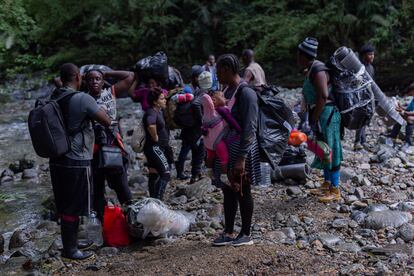The Gulf Clan-controlled Darién Gap sees record-breaking numbers of migrants
Human Rights Watch warns that the Colombia-Panama border situation stems from ineffective regional migration policies


An unprecedented number of migrants have recently crossed the daunting Darién Gap at the Colombia-Panama border. More than half a million people have made this journey in the past year, most of them heading north to the United States. The surge in migration through this hazardous jungle route is breaking records. The Colombian side of the Darién Gap is controlled by the Gulf Clan, a paramilitary group that adds even more danger to a journey that has turned into a full-blown humanitarian crisis.
“Venezuelans, Haitians, and Ecuadorians, but also people from other regions like Asia and Africa, risk their lives in this difficult terrain, where they are exposed to unchecked abuses by criminal groups, including sexual violence, and receive little protection or humanitarian assistance,” states the latest report by Human Rights Watch (HRW) on the Darién migrant route. “Over 440,000 Venezuelans have crossed the Darién Gap since January 2022 — the largest number for any nationality. They flee an ongoing humanitarian emergency in their country.” Ecuadorians and Haitians are also crossing the Darién Gap in large numbers. Since January 2022, over 80,000 Ecuadorians have crossed, fleeing increased violence in their country, as well as over 63,000 Haitians trying to escape a long-standing political, security and humanitarian crisis.
The jump in numbers is more than alarming. Around 130,000 migrants (mainly Haitians and Cubans) traveled through the Darién Gap in 2021. This nearly doubled to 250,000 in 2022, with large increases in Venezuelans and Ecuadorians. The number is expected to double again this year, as over 457,000 people have crossed as of September.
Once an impenetrable land barrier, the Darién is a place of sheer terror. Crisscrossed by broad, fast-flowing rivers, the terrain is treacherously steep and slippery. Recent site visits by HRW confirmed that most of the trails used by migrants wind their way over ranges up to 5,850 feet (1,800 meters) high — the migrants call the highest point “Death Mountain.” Then there’s “Death River,” the raging Turquesa River that has claimed so many migrant lives. The International Organization for Migration (IOM) has reported that at least 229 people went missing in Darién between January 2021 and September 2023. However, the exact number of fatalities remains unknown as many are never reported.
HRW’s report — This Hell Was My Only Option — is the first in a series on migration via the Darién Gap. It documents how a lack of safe and legal pathways has pushed migrants and asylum seekers fleeing human rights crises in Latin America to risk their lives crossing this terrain. It suggests that travel restrictions by South American countries, often promoted by the United States government, have contributed to sharp increases in numbers of people crossing the Darién Gap, exposing them to abuses, including sexual violence, and empowering organized crime in the area. An earlier HRW report warned that visa restrictions by several countries in the Americas caused a jump in the number of Venezuelans who are exposed to dangerous natural conditions, and robbery and rape by armed groups.
“What is happening in the Darién Gap is the result of a range of failed policies across the hemisphere — and the urgent need for a rights-respecting response to protect people fleeing human rights crises in the region,” states the latest HRW report, which recommends that these governments implement a region-wide temporary protection regime that would grant all Venezuelans and Haitians legal status for a “reasonably timed and renewable term.”
Migrants are at the mercy of criminal groups that operate with total impunity. “On the Colombian side of the Darién Gap, the Gulf Clan, an armed group involved in drug trafficking, regulates the routes that migrants and asylum seekers can use, decides who can assist them on the way, extorts people who benefit from migrant flows, and establishes rules of conduct for locals and migrants alike, at times enforcing them through violence.” The Colombian military estimates that the Clan collects an average of $125 per person crossing the Darién Gap. If the estimate is correct, HRW believes the Gulf Clan may have collected $57 million from migrants as of October this year.
HRW and several other organizations have denounced the Gulf Clan’s control over the area and its role in migrant trafficking. “No paved road traverses this isthmus, which has tormented explorers and resisted the reach of states for centuries,” said a recent report by the International Crisis Group. “But as displacement surges worldwide, people are crossing the Darién’s jungles in huge numbers. Locals have abandoned traditional livelihoods to service the migrants. Behind them lurks Colombia’s largest criminal group, which dominates drug trafficking and other rackets in the area.” Colombia’s Ideas for Peace Foundation (FIP) says that the Gulf Clan’s control over the area remains intact, “despite one of the most robust intelligence operations and legal investigations in Colombia’s recent history.”
Sign up for our weekly newsletter to get more English-language news coverage from EL PAÍS USA Edition
Tu suscripción se está usando en otro dispositivo
¿Quieres añadir otro usuario a tu suscripción?
Si continúas leyendo en este dispositivo, no se podrá leer en el otro.
FlechaTu suscripción se está usando en otro dispositivo y solo puedes acceder a EL PAÍS desde un dispositivo a la vez.
Si quieres compartir tu cuenta, cambia tu suscripción a la modalidad Premium, así podrás añadir otro usuario. Cada uno accederá con su propia cuenta de email, lo que os permitirá personalizar vuestra experiencia en EL PAÍS.
¿Tienes una suscripción de empresa? Accede aquí para contratar más cuentas.
En el caso de no saber quién está usando tu cuenta, te recomendamos cambiar tu contraseña aquí.
Si decides continuar compartiendo tu cuenta, este mensaje se mostrará en tu dispositivo y en el de la otra persona que está usando tu cuenta de forma indefinida, afectando a tu experiencia de lectura. Puedes consultar aquí los términos y condiciones de la suscripción digital.
More information

The other voices of the Darién Gap
Archived In
Últimas noticias
Most viewed
- Sinaloa Cartel war is taking its toll on Los Chapitos
- Oona Chaplin: ‘I told James Cameron that I was living in a treehouse and starting a permaculture project with a friend’
- Reinhard Genzel, Nobel laureate in physics: ‘One-minute videos will never give you the truth’
- Why the price of coffee has skyrocketed: from Brazilian plantations to specialty coffee houses
- Silver prices are going crazy: This is what’s fueling the rally








































